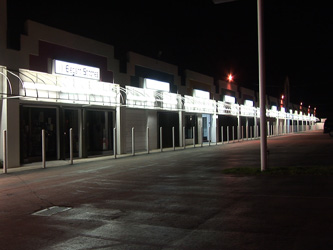Gretchen Skogerson, Still from DRIVE THRU, 2006.
Born 1970 in Teaneck, New Jersey; lives in New York, New York
Neatly centered in a wide-screen frame, silent against the ambient drone of passing tra≈c, a pale rectangle of light hangs suspended in darkness. Four long fluorescent lightbulbs horizontally stacked at a slight diagonal pulse with erratic, hypnotic rhythm; a fifth has gone out, disrupting the symmetry. Next, a single bulb appears, positioned at the same angle, and a sudden swell of primitive dance beats rises on the soundtrack, quickly dispelled by the barking of a dog. More fluorescent lights follow, in varying arrangements and states of disrepair—these are the opening images of DRIVE THRU (2006).
If the new, almost 20-minute video by Gretchen Skogerson suggests a Dan Flavin sculpture gone to seed, the title she gives to her ongoing project of experimental shorts, The American Disaster Series, evokes the Death and Disaster paintings of another sixties icon, Andy Warhol. While the nature of the calamity in DRIVE THRU is never specified, more than pretty lights come into view as the artist widens the early, abstract perspective of her shots. Fragments of words enter the frame, collaged alongside the fluorescent tubes: “LA,” “EN,” “Ra Jewelers,” “BIKES.” The work is “a landscape of incomplete signs,” as Skogerson has described it, in a very literal sense, documenting bits and pieces of signage from strip malls, gas stations, fast-food restaurants, and small businesses. Pulling back her perspective even farther, the tip of a palm tree sways against the night sky, cars zip by on nocturnal errands, and ghostly human figures emerge and retreat into the shadows. The soundtrack, meanwhile, continues its peculiar mix of natural and manufactured noises, unifying the images and strengthening the sense that a specific geographic region—desolate, urban, working class, temperate—is being contemplated.
Skogerson’s “talking mirror” installation PS (2005) anticipates the reflective, circumspect nature of this later work: beckoned by an electronic voice whispering “psst,” viewers are invited to close proximity with their own reflection, upon which the mirror discloses a secret. DRIVE THRU is likewise predicated on a reticent disclosure, albeit one revealed by the gradual widening of perspective: the video comprises images captured on the tattered streets of Miami in the wake of Hurricane Ivan in 2004. Without identifying this source material, DRIVE THRU examines the aesthetic paradoxes of disaster in terms at once local and universal, specific and abstract, finding structure within ruin, Minimalism in the mundane, elegance in the shattered, and light in the dark. NATHAN LEE
Gretchen Skogerson, Still from DRIVE THRU, 2006. High-defintion video, color, sound; 19:40 min. Collection of the artist

























